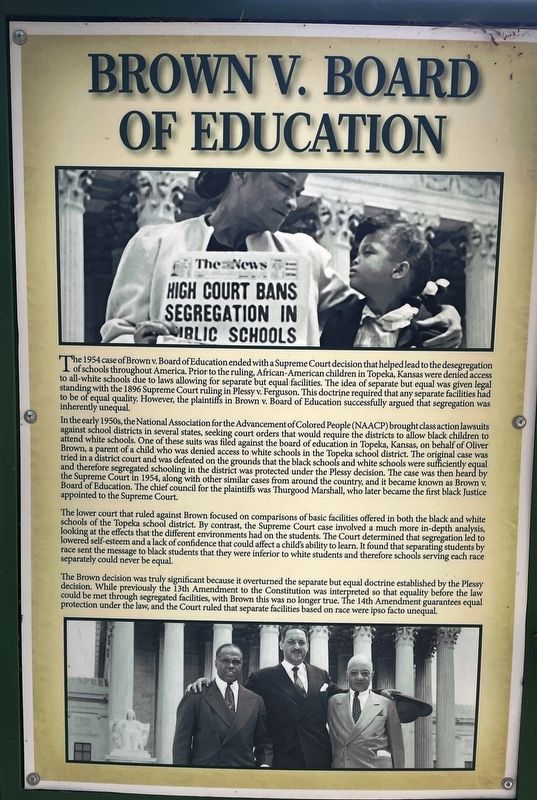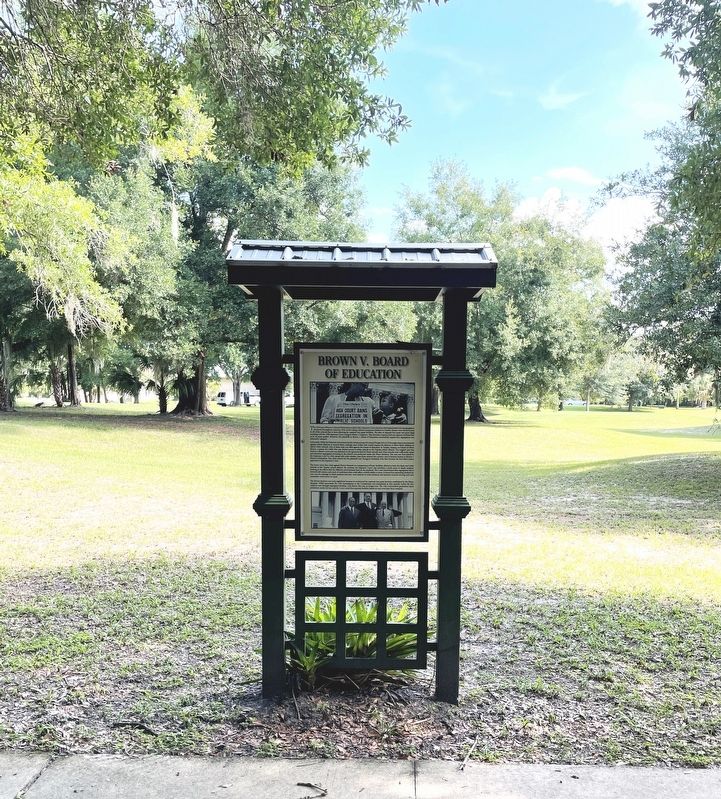Mims in Brevard County, Florida — The American South (South Atlantic)
Brown v. Board of Education
Harry T. & Harriette V. Moore Memorial Park
The 1954 case of Brown v. Board of Education ended with a Supreme Court decision that helped lead to the desegregation of schools throughout America. Prior to the ruling, African-American children in Topeka, Kansas were denied access to all-white schools due to laws allowing for separate but equal facilities. The idea of separate but equal was given legal standing with the 1896 Supreme Court ruling in Plessy v. Ferguson. This doctrine required that any separate facilities had to be of equal quality. However, the plaintiffs in Brown v. Board of Education successfully argued that segregation was inherently unequal.
In the early 1950s the National Association for the Advancement of Colored People (NAACP) brought class action law suits against school districts in several states, seeking court orders that would require the districts to allow black children to attend white schools. One of the suits was filed against the board of education in Topeka, Kansas, on behalf of Oliver Brown, a parent of a child who was denied access to white schools in the Topeka school district. The original case was tried in a district court and was defeated on the grounds that the black schools and white schools were sufficiently equal and therefore segregated schooling in the district was protected under the Plessy decision. The case was then heard by the Supreme Court in 1854, along with other similar cases from around the country, and it became known as Brown v. Board of Education. The chief council for the plaintiffs was Thurgood Marshall, who later became the first black Justice appointed to the Supreme Court.
The lower court that ruled against Brown focused on comparisons of basic facilities offered in both the black and white schools of the Topeka school district. By contrast, the Supreme Court case involved a much more involved a much more in-depth analysis, looking at the effects that the environments had on students. The Court determined that segregation led to lowered self-esteem and a lack of confidence that could affect a child’s ability to learn. It found that separating students by race sent the message to black students that they were inferior to white students and therefore schools serving each race separately could never be equal.
The Brown decision was truly significant because it overturned the separate but equal doctrine established by the Plessy decision. While previously the 13th Amendment to the Constitution was interpreted so that equality before the law could be met through segregated facilities, with Brown this was no longer true. . The Fourteenth Amendment guarantees equal protection under the law, and the Court ruled the separate facilities based on race were ipso facto unequal.
Erected by Harry T. & Harriette V. Moore Memorial Park.
Topics. This historical marker is listed in these topic lists: African Americans • Civil Rights • Education. A significant historical year for this entry is 1954.
Location. 28° 39.224′ N, 80° 50.717′ W. Marker is in Mims, Florida, in Brevard County. Marker can be reached from Freedom Avenue, 0.3 miles south of Parker Street, on the left when traveling south. The marker stands within the Harry T. & Harriette V. Moore Memorial Park and Museum. Touch for map. Marker is at or near this postal address: 2180 Freedom Avenue, Mims FL 32754, United States of America. Touch for directions.
Other nearby markers. At least 8 other markers are within walking distance of this marker. Groveland Four (a few steps from this marker); Little Rock Nine (a few steps from this marker); Dr. Mary Jane McLeod Bethune (within shouting distance of this marker); Violence In Hemming Plaza (within shouting distance of this marker); Freedom Riders (within shouting distance of this marker); Rosewood Massacre - 1921 (within shouting distance of this marker); Voting Rights Act (within shouting distance of this marker); Eatonville (within shouting distance of this marker). Touch for a list and map of all markers in Mims.
Also see . . . Brown v. Board of Education. (Submitted on August 18, 2021, by Brandon D Cross of Flagler Beach, Florida.)
Credits. This page was last revised on August 19, 2021. It was originally submitted on August 18, 2021, by Brandon D Cross of Flagler Beach, Florida. This page has been viewed 459 times since then and 156 times this year. Photos: 1, 2. submitted on August 18, 2021, by Brandon D Cross of Flagler Beach, Florida. • Devry Becker Jones was the editor who published this page.

